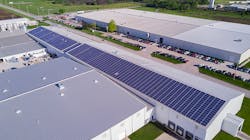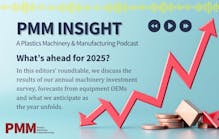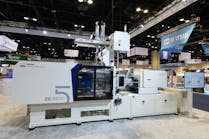Solar, battery storage combo brings energy savings to Iowa blow molder
Agri-Industrial Plastics (AIP) is a 400,000-square-foot blow molding processor operating 28 machines 24 hours a day, five days a week.
The Fairfield, Iowa, company for years has searched for ways to reduce electricity costs, and last year, it installed a 517-kilowatt (kW) roof-mounted solar array, which works in conjunction with a 212-kW (430 kilowatt-hour) Tesla Powerpack battery energy storage system. During the day, the solar panels power a small percentage of the plant’s energy needs, while charging the battery storage system so it’s available to supplement the plant’s needs during times of high energy usage. Combining the solar panels with the battery allows the plant to engage in a practice called peak shaving, which reduces costly demand charges.
Related stories: Tracking energy use lets processors take charge; Harbec succeeds in carbon-neutral quest; Pinpointing energy-guzzlers is key to saving money
Iowa-based Ideal Energy designed the system, the first of its type in the state to combine solar power with a Tesla Powerpack battery storage system.
The array will save AIP more than $42,477 per year and, compared with traditional systems, it will release 9,337 fewer tons of carbon dioxide into the atmosphere over the next 25 years, which is equivalent to more than 10 million pounds of coal, according to AIP.
“We’re always looking at ways to control our costs for the long term,” AIP President Lori Schaefer-Weaton said. “Obviously, our utility bill is a big one every month. It’s a major part of our cost structure, so, any way that we can bring that down is a good thing.”
In 2012, the company decided to cut its energy use in part by switching to more energy-efficient lighting. The plant had older metal halide lights illuminating the entire plant, and they were on all the time.
“We were constantly illuminating cardboard boxes in the warehouse,” said Geoff Ward, director of engineering and quality at AIP. “We switched to all fluorescents with motion sensors throughout the facility at that point.”
As energy prices continued to rise, the company looked at other solutions, including the possible installation of a solar panel system, but the economics did not initially make sense. Agri-Industrial Plastics relied on Ideal Energy to help find a solution.
“We’d been in conversations with them for four or five years,” Ward said. “It’s not like we jumped right out of the gate.”
The turning point came when Ideal Energy proposed the idea of pairing a solar array with the Tesla battery storage system. The return on investment (ROI) for the solar panel system alone would have been about 14 or 15 years, which “absolutely didn’t make any sense,” Ward said. However, when the energy storage system was added, the ROI dropped to nine years on an after-tax basis.
By storing energy, the battery system allows AIP to shave its energy usage from the power grid during periods of peak demand. This maximizes the value of the solar array, so that the energy it generates can be used even when the sun is not shining. Peak energy use can significantly drive up an electric bill, Ward said.
“That was a big piece of the puzzle for us,” he said.
“Their average usage when they are operational might be somewhere around 2.5 megawatts, but they will have spikes during the course of the day that might go up to 2.7, 2.8 or 2.9 megawatts, and those spikes are quite expensive for them,” said Aurelien Windenberger, director of finance and design at Ideal Energy. “The battery can kick on anytime day or night when Agri-Industrial Plastics would hit a peak.”
However, reducing the company’s electric bill was not the only objective, Schaefer-Weaton said. The company also wanted to burnish its reputation among its employees and customers for tackling sustainability issues.
“This solar project was a chance for us to really shine in terms of what makes us different,” she said. “We are not your typical old-school manufacturing company. We do care about conserving energy for the long haul.”
Most of Agri-Industrial Plastics’ OEM customers have their own sustainability targets or goals, and AIP’s use of solar energy can help them achieve those goals.
The combined solar and battery storage system allows the company to reduce the cost of energy purchases from the power grid by about 10 percent, Ward said. The amount of electricity purchased from the power grid has dropped by about 5 percent. The size of the facility and the amount of energy its blow molding operation requires means that it is not feasible for the company to install a solar array large enough to meet all its needs.
The availability of federal, state and local tax credits also plays a major role in the affordability of solar panel installations. For those considering a solar power installation at their manufacturing facility, Windenberger cautions that less funding may soon be available.
“The federal tax credit at the moment is 26 percent of the cost of the system, and that currently is declining,” he said. “In 2021, that tax credit drops to 22 percent, and in 2022, it drops to 10 percent.”
The impending loss of federal assistance might be an incentive for some companies to consider installing a solar power system this year or next “because that’s going to be a pretty big drop down after 2021,” Windenberger said.
Agri-Industrial Plastics was founded in 1978 and specializes in manufacturing fuel tank systems for non-automotive applications.
Bruce Geiselman, senior staff reporter
For more information
Agri-Industrial Plastics Co., Fairfield, Iowa, 641-472-4188, www.agriindustrialplastics.com
Ideal Energy Inc., Fairfield, Iowa, 641-209-3288, www.idealenergysolar.com/
Bruce Geiselman | Senior Staff Reporter
Senior Staff Reporter Bruce Geiselman covers extrusion, blow molding, additive manufacturing, automation and end markets including automotive and packaging. He also writes features, including In Other Words and Problem Solved, for Plastics Machinery & Manufacturing, Plastics Recycling and The Journal of Blow Molding. He has extensive experience in daily and magazine journalism.






